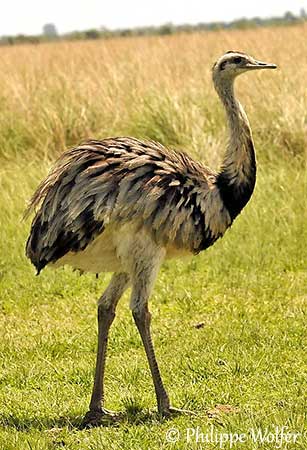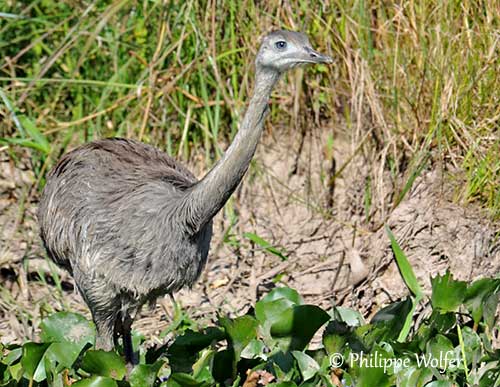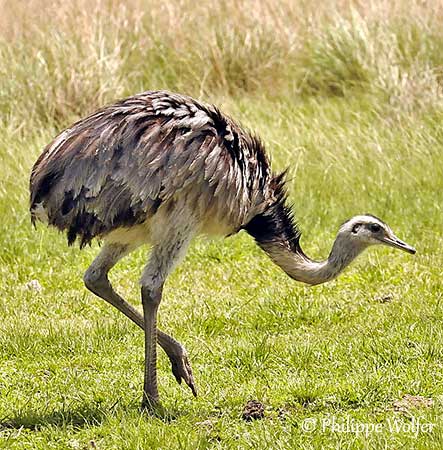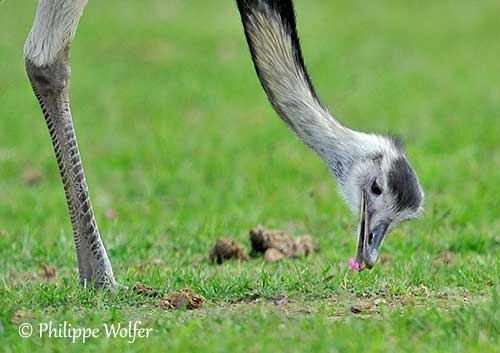
Fr: Nandou d’Amérique
Ang: Greater Rhea
All: Nandu
Esp: Ñandú Común
Ita: Nandù
Nd: Nandoe
Sd: större nandu
Photographers:
Philippe et Aline Wolfer
GALERIE
Text by Nicole Bouglouan
Sources:
HANDBOOK OF THE BIRDS OF THE WORLD vol 1 by Josep del Hoyo-Andrew Elliot-Jordi Sargatal - Lynx Edicions - ISBN: 8487334105
L’ENCYCLOPEDIE MONDIALE DES OISEAUX - Dr Christopher M. Perrins - BORDAS - ISBN: 2040185607
Animal Diversity Web (University of Michigan Museum of Zoology)
Arthur Grosset's Birds (Arthur Grosset)
Inside Germany’s Giant, Hungry, Flightless-Bird Problem
Smithsonian’s National Zoo & Conservation Biology Institute
What – when – how - Greater Rhea (Birds)
Greater Rhea
Rhea americana
Rheiformes Order – Rheidae Family
INTRODUCTION:
The Greater Rhea is the largest bird of South America and is related to ostriches and emus. It occurs in S and E South America, in Argentina, Bolivia, Brazil, Paraguay and Uruguay, from lowlands up to 1,200 metres of elevation.
A small population established itself in Germany, when one male and five females escaped from a farm in August 2000. The birds were able to survive the winter and a population estimated at about 250 individuals was reported at the end of the year 2017. This population is still increasing and today, hunting of these birds is allowed and eggs are destroyed by humans, in order to reduce the numbers.
The Greater Rhea is found in the grassy steppes of the pampas and savanna-type habitats, dense grasslands and scrub with scattered trees, and more often at wood edges and near farmland.
These birds are gregarious and often live in mixed groups including males, females and juveniles. They feed on a variety of plant matter such as roots, fruits, seeds and leaves, although insects and small vertebrates are also part of their diet.
The Greater Rhea is polygamous, involving males mating with many different females. The females lay their eggs in a ground nest selected by the male. The eggs are incubated by the male itself, and it also protects the young from predators.
The Greater Rhea is affected by hunting for meat and export of skins. Egg-collection and habitat fragmentation are other threats.
The species is described as “uncommon to fairly common” but the population is currently declining, and the Greater Rhea is classified as Near Threatened.

DESCRIPTION OF THE BIRD:
Biometrics:
Length: 127-140 cm
Height: 150-170 cm
Weight (male): 20-25 kg, but up to 40 kg
The Greater Rhea adult male has grey to greyish-brown upperparts, with dark brown to black crown, nape, neck base and upper back. The breeding male may show extensively whitish and swollen neck.
The underparts are whitish. The thighs are feathered whereas the tarsi are totally bare.
The head is fairly small compared to the body size.
The bill is yellowish-brown and fairly small (8-10,5 cm). The eyes are brown. The scaled legs are yellowish brown, and there are 22 horizontal plates on the front of the tarsus. The feet have three toes, and the hind toe is absent.
The male are generally darker than the females, but both sexes are very similar.
The juvenile resembles female. It reaches its full size in about six months. The young birds can start to breed around two years old.
It is not uncommon to find entirely white individuals, especially in the race “albescens”. The plumage is whitish and the eyes are blue.

SUBSPECIES AND RANGE:
The Greater Rhea has five subspecies that differ in extent of black on neck and upper back, and also in size.
R.a. americana (described above) is found in C and NE Brazil to S Brazil.
R.a. intermedia occurs in extreme S Brazil and Uruguay.
R.a. albescens is found in the Plains of Argentina S to Rio Negro.
R.a. nobilis occurs in E Paraguay.
R.a. araneipes is found in W Brazil, E Bolivia and W Paraguay.
But there is a population in N Germany. One male and five females escaped from a farm in 2000, and live now in the wild. They form a large group of about 500 individuals.
In 2000, the male and the females established the group and survived all during the winter. They were able to breed the following year. As the population is growing, the eggs are collected and destroyed, to maintain good numbers and to avoid they become crop pests. This population lives in an area of about 156 km² in the valley of the Wakenitz River.
HABITAT:
The Greater Rhea typically frequents low grasslands and pampas of South America. But they can also be seen in open woodlands and even saline marshes.
The birds have adapted to agricultural areas replacing the native plants with crops, as their wild habitat is disappearing.
They also frequent habitats close to water, and breed in more wet habitats.
In Germany, the Greater Rhea lives in open agricultural landscapes with fields, meadows, fallow lands, small forests, hedges and some water.

CALLS ANS SONGS: SOUNDS BY XENO-CANTO
Outside of breeding season, the Greater Rhea produces hoarse cries of alarm, grunts when they become aggressive and also hissing sounds.
Within the groups, the young birds utter plaintive whistles as vocal contact, especially when threatened.
During the mating season, the males produce deep, resounding “bu-up” or “nan-du” during the courtship displays. These sounds can be heard at a distance, and resemble the roar of a large mammal rather that a bird’s call. They are sometimes given at night.
These sounds are produced with the bill closed, but after filling the chest with air.
BEHAVIOUR IN THE WILD:
The Greater Rhea is omnivorous, but it primarily feeds on plant matter, both wild and cultivated plants. The main diet includes grass, leguminous crops and agricultural grain. However, it also takes small vertebrates such as small birds, fish and snakes, and sometimes insects. It also ingests small stones to make easier the grinding of food. It occasionally consumes fresh faecal matter of other rheas.


The Greater Rhea feeds by walking slowly with the head about 50 centimetres above the ground. It raises it only to swallow the food and to watch the surroundings. It forages during the day, alone or in groups outside of breeding season.
The Greater Rhea is a walking bird and uses its strong legs to move over large distances. But it runs only when threatened, or to impress a potential mate.
During the breeding season, they form social groups of individual males, groups of females and flocks of young with non-reproductive males.
The males fight for territories, running round in circle together, intertwining their necks and sometimes biting and kicking each other. The winner chases away other males from its territory, and tries to attract females into its domain, running quickly towards them with wings wide open.
The courtship displays start when several females (2 to 12) have been attracted. The male runs in zigzag pattern and uses both wings and neck to steer in different directions. It runs around the group of females while giving the typical “boom” sound. The neck is erect and inflated and the wings are raised.
At the end of the displays, the male stands beside the females. The neck is lowered in a U-shape while neck and head feathers are bristled up. It also shakes its wings before stretching them out to the sides, while the feather tips quiver softly in the wind.

The male copulates with several females and then, it leads them to a nest it has previously selected and prepared. The females will lay their eggs in the same nest and the male will incubate alone.
Then, the females leave the nest-site to mate with other males and lay the eggs in other nests. This behaviour continues for the rest of the season.
The Greater Rhea is sedentary.
It is flightless, but despite the inability to fly, this species has large, powerful wings. The bird uses them like sails for bursts of speed while running, and for balance when turning.

REPRODUCTION OF THIS SPECIES:
The breeding season takes place between July and January, depending on the region in South America.
In Germany, the non-native population breeds between April and August, sometimes from late March.
The nest-site is selected by the male. The nest is a shallow depression sheltered among vegetation. The male tramples the surrounding vegetation with the feet, and cuts the grass with the bill, creating a clean area of 2-3 metres wide around the depression. Then, the male sits on the nest and rotates slowly in a circle while pushing backwards with the feet, forming a mound of 1,40 metre across with an interior depth of 30 centimetres. The nest is lined with grass, feathers, debris and sticks. It is circular with a diameter of 90 centimetres and a depth of 30 centimetres.
The male is on the nest when the laying occurs. It becomes aggressive when a female approaches, and covers the nest with its wings. But it gradually allows her to crouch and lay her egg at the edge of the nest. Then, the male rolls it into the nest.
The eggs weight 600 grams. They are first greenish-yellow, but they become dull cream when exposed to the light.
The male incubates alone during 27-43 days. The eggs hatch within 36 hours of each other. The male sometimes leaves the nest during the warmest hours of the day.
At hatching, the chicks are grey with dark stripes. They grow quickly and reach the full size in about six months. The male protects them during this time. They can breed at two years.

The Greater Rheas adults are killed by mammals such as Puma concolor and Panthera onca (cougar and jaguar). The young birds are killed by feral dogs, whereas the hatchlings are taken by the Southern Crested Caracara - Caracara plancus. The Armadillos may consume the eggs.
PROTECTION / THREATS / STATUS:
The Greater Rhea has large range in which it is described as “uncommon to fairly common”.
The population is suspected to be declining, due to hunting for meat and export of skins, but habitat destruction and fragmentation also affect the species, especially in the pampas.
The Greater Rhea is sometimes considered a pest by farmers because it eats broad-leaved crop plants. In this case, the birds are killed by the farmers.
In Germany, the species is legally protected like all native species.
The Greater Rhea is currently classified as Near Threatened.
